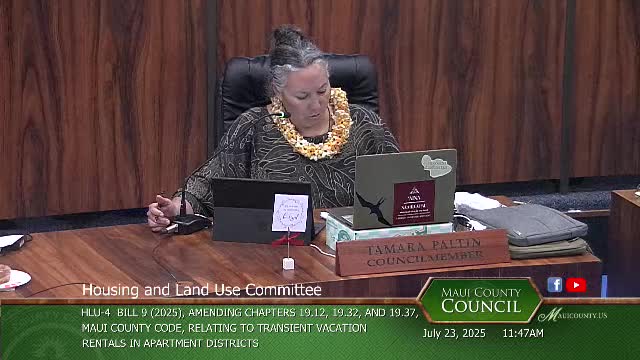Maui County Reports 21 Percent of Housing Units as Transient Vacation Rentals
July 23, 2025 | Maui County, Hawaii
This article was created by AI summarizing key points discussed. AI makes mistakes, so for full details and context, please refer to the video of the full meeting. Please report any errors so we can fix them. Report an error »

In a recent meeting of the Maui County Housing and Land Use Committee, significant discussions centered around the current state of housing and transient vacation rentals (TVRs) in the region. The meeting, which reconvened after several previous sessions, highlighted critical data from the U.S. Census Bureau's American Community Survey and insights from the University of Hawaii Economic Research Organization (UHERO).
One of the key points raised was the existence of approximately 13,000 transient vacation rental units in Maui County, which accounts for 21% of all housing units. However, there are currently about 10,084 units actively listed for rental, indicating a difference of 2,916 units. This discrepancy raises questions about the availability and regulation of these rentals, as not all units are listed for rent every day.
The committee discussed the source of the active listing data, which comes from the state Department of Business, Economic Development, and Tourism. This data is tracked through contractors monitoring platforms like Airbnb and VRBO. The lower number of actively listed units compared to the total number of TVRs suggests that many properties may not be consistently available for rental, complicating the housing landscape further.
Additionally, the committee examined trends in owner-occupied units within Minatoia complexes. Data indicated a decline in owner occupancy from 81% to 73% over a specified period. This statistic reflects broader trends in housing stability and ownership within the community, raising concerns about the long-term implications for housing availability and community cohesion.
The discussions underscored the ongoing challenges Maui faces regarding housing supply, the impact of transient rentals on the local market, and the need for effective regulation to balance tourism and residential needs. As the committee continues its work, these issues will remain at the forefront of discussions, with potential implications for future housing policies and community development strategies.
One of the key points raised was the existence of approximately 13,000 transient vacation rental units in Maui County, which accounts for 21% of all housing units. However, there are currently about 10,084 units actively listed for rental, indicating a difference of 2,916 units. This discrepancy raises questions about the availability and regulation of these rentals, as not all units are listed for rent every day.
The committee discussed the source of the active listing data, which comes from the state Department of Business, Economic Development, and Tourism. This data is tracked through contractors monitoring platforms like Airbnb and VRBO. The lower number of actively listed units compared to the total number of TVRs suggests that many properties may not be consistently available for rental, complicating the housing landscape further.
Additionally, the committee examined trends in owner-occupied units within Minatoia complexes. Data indicated a decline in owner occupancy from 81% to 73% over a specified period. This statistic reflects broader trends in housing stability and ownership within the community, raising concerns about the long-term implications for housing availability and community cohesion.
The discussions underscored the ongoing challenges Maui faces regarding housing supply, the impact of transient rentals on the local market, and the need for effective regulation to balance tourism and residential needs. As the committee continues its work, these issues will remain at the forefront of discussions, with potential implications for future housing policies and community development strategies.
View full meeting
This article is based on a recent meeting—watch the full video and explore the complete transcript for deeper insights into the discussion.
View full meeting
